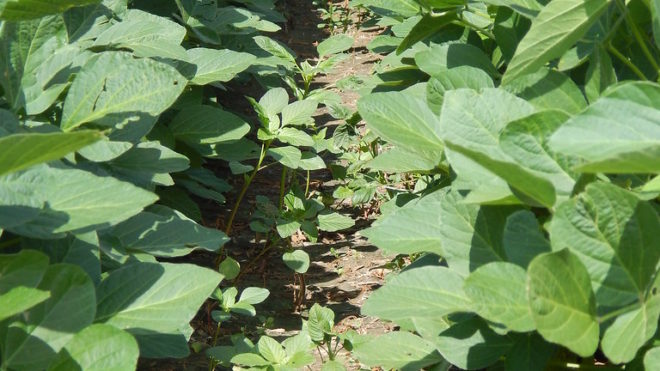Weed seed bank likely increased during 2019 season.
Herbicide systems and weed control will be very important to corn and soybean crops in 2020.
“In 2019, we had prevent plant, beans planted late and when we wanted to spray, we couldn’t get in the field so the weeks got a jump on us and that is going to increase our weed seed bank,” said Jon Skinner, Beck’s Hybrids Northern Illinois field agronomist.
“And we saw a lot of flooding, so there was soil movement, residue movement, and seed movement,” Skinner said during a Beck’s Hybrids PFR Insight Meeting. “So, this year, you may be introduce to new species of weeds on your farm and to some weeds that are resistant that you haven’t had before.
To control weeds, Skinner said, it is important to know what species of weeds are in the field and if they are resistant to herbicides.
“When we rely on one herbicide family that increases pressure on herbicides, so if you’re only using one mode of action to kill a weed, it can evolve and become resistant to that mode of action,” he said.
Weeds are classified into five emergence groups.
“Group O weeds typically germinate in the fall, but have been known to germinate 10 months out of the year,” Skinner said. “An example is marestail, and it is a moving target because you never know when they’re going to come about.”
Giant ragweed is a Group 1 weed.
“Typically that weed will emerge before corn planting, so if we don’t have a pre-emerge herbicide that has activity on already growing weeds, giant ragweeds can have a jump on us,” Skinner said.
“It doesn’t emerge for very long, so if you can start clean with a burndown, come in with a pre-residual, that will give you mostly season-long control of giant ragweed.”
Waterhemp is a Group 4 weed that doesn’t emerge until after 300 growing degree units.
“You calculate the GDUs from Jan. 1 not from the corn planting date, so it’s about mid-June to early July timeframe,” Skinner said. “That’s about the time of a lot of our pre emerge herbicides are wearing off, so we should come in before that and layer in another residual to kill the waterhemp.”
Skinner reported results of data from PFR sites where multiple modes of action herbicide programs were tested.
“If we use a single mode of action as a pre emerge, we got 60% control of waterhemp and by layering in two modes of action, we move that to 89% control,” he said. “If we mix three effective modes of action, we jump the weed control to 97%.”
Competition also can help reduce weed pressure in soybeans which can be accomplished by planting in narrower rows.
“Fifteen-inch rows suffer less from weed pressure for yield reduction versus 30-inch rows,” Skinner said.
Another strategy is to plant soybeans earlier, so the crop is growing before the Group 3 and 4 weeds have time to emerge.
Preston Brown, Beck’s Hybrids seed adviser, talked about the challenge farmers are facing with reduced time for optimal planting opportunities.
“Our planting windows over the last five to 10 years continue to get smaller and smaller,” he said. “To overcome that you need to plant more acres in less amount of time or be more efficient.”
Seeding with a 16-row planter at 5 mph will result in covering about 17 acres per hour.
“If you use a 24-row planter, that increases your acres per hour by 50%,” Brown said.
“This past year, we tested SpeedTubes from Precision Planting,” he said. “Our goal is to test a product that can be applied to almost any planter.”
For the test, Beck’s planted corn with five different passes — a standard seed tube at 5 mph and using a SpeedTube at 5, 7, 10 and 12.5 mph.
As seed goes from the meter to the trench, it goes through three stages — Stage 1 which is the launch, Stage 2 the falling and Stage 3 the landing.
“We’ve done a really good job with most planters to launch the seeds well, and we’re pretty good with the landing to put the seeds in the right spot,” Brown said.
“The falling stage is really what Precision is trying to overcome the challenges because when you go faster on a standard unit the seeds can bounce around and anytime there’s a bounce, the seed won’t land exactly where you want it.”
The SpeedTube, Brown said, has a conveyor belt through Stage 2 that features individualized pockets for each seed.
“This belt runs at a consistent rate as you move to higher speeds from launch to landing to control the seed,” he said.
In the Beck’s trials, Brown said, when comparing the average spacing with the SpeedTube at 5 mph to 12.5 mph, there is barely a one-quarter inch difference.
“Even though we’re increasing speed two times-plus, we can get really consistent spacing,” Brown said.
“By going from a standard seed tube to a SpeedTube, we saw a 1.7-bushel advantage in corn at 5 mph,” he said. “And we saw a 0.7 bushel advantage at 12.5 mph even as we’re increasing speed dramatically, so SpeedTubes can bring consistent performance.”
~Martha Blum – AgriNews website

